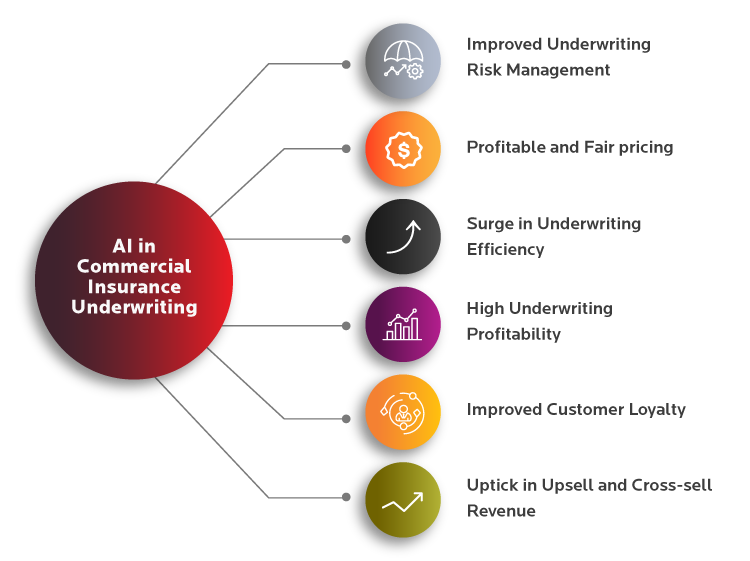In the commercial line, manual underwriting is dotted with piles of physical and digital paperwork, countless instances of rekeying data to check for application completeness, multiple back-and-forths between client representatives, decision-makers, and 3rd parties - not to mention a lengthy and cumbersome risk analysis process which relies on non-specialized software and browser searches to assess the risk profile of an application. However, such efforts only make room for procedural errors, quality issues, inefficient pricing, suboptimal loss ratios - at the same time, they also incur high costs against expensive person-hours while making inefficient use of expert talent. The result? Commercial insurance quotes take 2-3 days to reach the client in some of the most efficient manual underwriting-based operations.
Six Ways Artificial Intelligence is Transforming Commercial Insurance Underwriting
Insurance underwriting automation has already transformed the retail lines in this industry, and leaders now promise instant quote and issuance to their customers with attractive prices geared to retain customers. However, in the commercial lines, AI-based insurance underwriting is defining new pillars of operational and strategic excellence. Here are six ways AI can help commercial insurers achieve new heights of operational and strategic excellence.
1. Improved Underwriting Risk Management
In the commercial lines, every application posits a new set of risk variables that are becoming increasingly complicated to assess and account for in the risk analysis strategy with precision. Using artificially intelligent systems that assess an application profile against billions of data points accrued from 3rd party sources, underwriters can now gain visibility into the most relevant risk factors associated with a client profile. In specialty lines like cyber insurance, gaining complete visibility into the risk exposure of an enterprise's IT systems and appropriately translating these risks into profitable numbers for the business can be an impossible task for humans.
The current commercial insurance sector is symptomatic of inefficient risk management. According to a McKinsey study, this is evident from a 23-28% difference in the loss ratios logged by the top and the bottom quintile of performers. AI-driven underwriting systems assist the underwriters by accurately quantifying unstructured and qualitative data points - like social media and news feeds, reliable statistics from public sources, and 3rd parties - and convey a comprehensive risk profile to the underwriters in a highly interpretable manner. This can drastically improve loss-ratios and standardize a 360-degree approach to risk analysis across the insurer's underwriting function.
2. Profitable and Fair Pricing
According to a McKinsey study, a small business owner looking for commercial P&C insurance received coverage amounts differing by a staggering 233% from five providers - for almost the same risk. At the same time, companies like AIG pay $75m every day due to losses arising from the commercial line alone. This demonstrates the pricing inefficiencies that benchmark the current landscape in the commercial lines, and more importantly, fail to capture the risk profile appropriately through a profitable pricing strategy. AI-driven underwriting brings complete risk visibility into a case. These factors are then used to suggest the best possible pricing options and coverage terms to the underwriters - that act as informed gatekeepers responsible for course corrections.
AI-driven underwriting analyses a risk profile in the purview of evolving geopolitical risks, more extensive ecosystem variables, social media sentiments, Geospatial Information Systems (GIS), and real-time data from IoT networks/3rd parties to appropriately appraise premiums while also accounting for retention conditions and customer delight within the pricing strategy. Most commercial lines have seen success with predictive ML solutions in rolling out fairly-priced quotes fast and achieving higher profitability through their pricing strategy.
3. A surge in Underwriting Efficiency
In the manual underwriting process, most high-value accounts take over weeks to receive a quote post-application. Underwriting is one of the most time and resource-intensive processes in the commercial insurance customer life-cycle. AI-assisted underwriting changes the equation through RPA and building intelligence into the system for light tasks while keeping human attention dedicated to the most complex tasks and for the final decisioning. For example, in conjunction with a minimally inquisitive digital application process and integrated application infrastructure, AI-driven underwriting systems can help underwriters issue a quote for high-value accounts on the date of application.
Also, AI-driven underwriting calls for a process redesign in the pre-implementation stage, which introduces standard operating procedures, coherence, and builds best practices into the underwriting process - for example, automatically assessing application completeness or pricing coverages such that the customer keeps coming back. Standardization builds predictability into day-to-day operations, while RPA technologies like intake automation enable the completion of tedious and repetitive tasks like data collation, find-and-rekey, checklist-based assessments, and other quality assurance measures at the touch of a button. Lastly, AI-driven underwriting systems are not bottlenecked by capacity and bring inherently low bias into underwriting decisioning.






